Ten Fun Mango Facts
Happy July, friends! It’s mango season!
While mangoes can be harvested year-round in parts of the United States, the hot summer months of June and July are considered peak season for mangoes because so many varieties (or cultivars) are ripening this time of year.
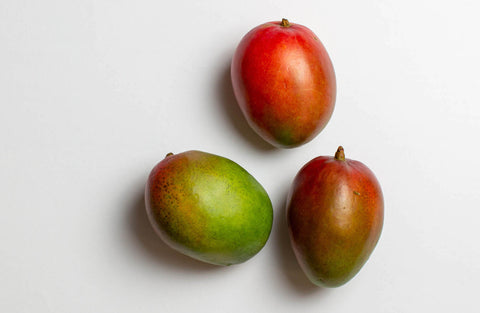
Introduced to south Florida over 200 years ago, mangoes are now at the center of summer culture in the Keys, where festivals are held in the blazing heat to celebrate this sweet and juicy tropical fruit. Neighbors share bounties from trees growing right in their backyards, and South Florida grandmas bake up mango breads and swirl together mango milkshakes for sweet summer treats.
If you don’t live in South Florida, mango season means $0.25 mangoes at the grocery store – still not a bad way to celebrate.
So other than that they taste amazing and go on sale at the end of June, how much do you really know about mangoes?
I asked myself this question and did some digging, and I’m stoked to share my research with you! From the least nutritious variety to the top exporting countries, here are TEN things you (maybe) didn’t know about mangoes!
Ten Fun Facts You (Maybe) Didn't Know About Mangos!
1. Mango is in the same family as cashews and pistachios
Yep, it’s true. The mango, or Mangifera indica, is part of the Anacardiaceae family, a family of flowering plants that bear fruits known as drupes (a.k.a. stone fruits!). Drupes are fruits with an outer fleshy part and a stone (or pit) in the middle. If this reminds you more of an avocado than a cashew, you’re not alone, it took me some time to pin down the difference. An avocado, botanically speaking, is a single-seeded berry, since it has a seed rather than a pit, and the innermost layer is soft and “fleshy.” In a mango, the seed is inside the stone (or pit), which is a hardened layer around the seed. Other notable Anacardiaceae family members are poison ivy, sumac, and marula, which is an important fruit to the people of southern Africa and even used to make beer there!

2. The plural form of mango is…
Mangoes. Or Mangos. [Scratches head.] Apparently, it’s perfectly fine to use either spelling. Though, I found mangoes to be the preferred and more common spelling. So calm down grammar police, it’s correct either way.
3. Mango is ridiculously high in Vitamin A
You wouldn’t be surprised to hear that mangoes are high in vitamin C, they are a yellowish-orange tropical fruit after all. But did you know that mangoes are one of the best plant sources of vitamin A?
Vitamin A is an essential nutrient that humans can’t produce on our own and must get from food. Vitamin A supports many systems in the body, including daily replacement of skin cells, maintaining healthy tissue in the eyes, and providing a barrier to infection through mucous production.
There are two types of vitamin A – retinol (animal sources) and carotenoids (plant sources). Retinol is an active form of vitamin A, which is how the body uses it. Egg yolks, liver, and fish liver are all good sources of retinol. Carotenoids, on the other hand, must be “converted” to retinol during digestion. Carotenoids like beta carotene are what give fruits their color and contain antioxidant properties. Antioxidants protect cells from damage caused by free radicals, which are believed to contribute to certain chronic diseases.
( For some excellent, in-depth info about vitamin A, I highly recommend this article)
4. But not if you buy this most common variety
A mango is a mango right? Oh, how little I knew about mangoes.
Sad but true, some mango cultivars are less nutritious than others. In fact, if you’re not paying attention, you’ll likely pick up the least nutritious variety - it's the most common!
A study conducted by the USDA Agricultural Research Service found vast differences in vitamin A and C amounts between five common mango cultivars. While all mangoes tested were still considered “excellent” sources of vitamins A (beta-carotene) and C (ascorbic acid), the Mexican grown Ataulfo variety scored highest for both nutrients.
On the other end of the spectrum lies the most common commercially distributed cultivar – the Tommy Atkins. Tommy Atkins mangoes contain only a fifth of the beta-carotene of Ataulfos, and the lowest levels of vitamin C of the varieties tested.
The lesson - if you're looking for the very best fruit source of beta carotene, pick up a cantaloupe.
5. There’s a difference in taste, too
Tommy Atkins mangoes are the most commercially distributed mangoes for a reason. They are tough and resilient, making them tolerant to shipping and handling without bruising. Originally planted from a Haden mango seed in the 1920s by Thomas Atkins of Broward County, Florida, this cultivar was actually rejected by the Florida Mango Forum for its “unremarkable” quality. But by the 1950s, it finally became popular with commercial growers and went on to become the most extensively planted mango in North and South America.
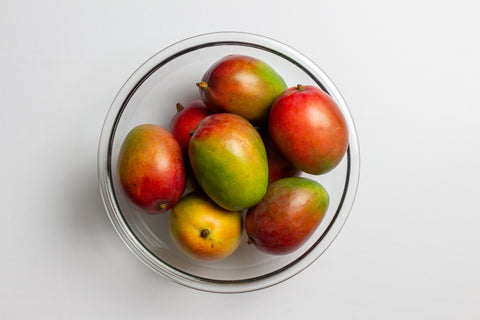
The Tommy Atkins mango is less sweet and more fibrous. It has even been described across the internet as “tasteless,” “so lame,” and “a mango I would eat last if it was the only one available.” That’s pretty harsh!
While I can’t disagree with the criticism of its stringy texture, when a Tommy Atkins is ripe, it tastes pretty darn good to me. But if you are looking for a heavenly mango experience (with the nutrient-dense qualities of a true super fruit) it may be best to pass on those $0.25 Tommy Atkins mangoes, and pick up a Haden, Honey, or Ataulfo instead.
6. Mango is higher in sugar than most fruits
There’s a reason they taste so good. One medium mango (336 grams edible portion) contains 200 calories and 46 grams of sugar. If you’re watching your sugar, you may think to stay away from this super sweet fruit, but not so fast. Sugars from whole foods like mango don’t have the same effect on your diet as added sugars.
For one, it’s just too hard to overeat fruits, which are full of fiber and water, opposed to added sugars which are just empty calories. Plus, mangoes are good for you and there are benefits to indulging in this delectable fruit. Mango contains such high amounts of micronutrients like vitamins A and C, that avoiding them isn't doing your health any favors.
However, if you frequently add mango to smoothies, or juice this delicious fruit, best to watch how many you are consuming. Blended foods don’t provide the same fullness factor as when they are chewed, so it still may be possible to overindulge.
And if you're using half at a time, Ideal Wrap is the perfect way to save the other half for later!
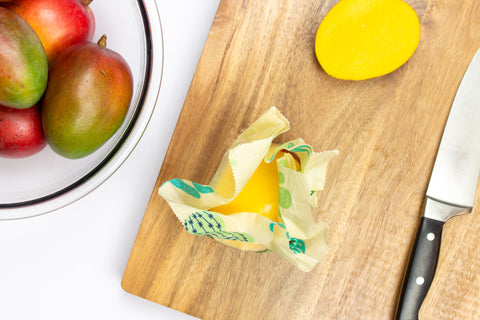
7. India produces (and consumes!) more mangoes than any other country
Annual mango production in India reaches over 18 million tons – roughly 50% of the entire global supply!
Mango is native to India as well as its national fruit, and it is commonly referred to as “foods of the gods” and “king of fruits” there. Mangoes have been cultivated in India and south Asia for thousands of years. In fact, the earliest mention of Mangifera indica (which literally means, an Indian plant bearing mangoes, but also, the great fruit bearer) is in Hindu scripture dating back to 4000 B.C.E.
If you love Indian food, you’ve likely tried a mango curry or dal at your favorite Indian restaurant. And if you’ve never tried the Mango Lassi on the menu, you’re seriously missing out. Of course, now that mangoes are in season, you can easily make one yourself. (https://thewanderlustkitchen.com/how-to-make-a-mango-lassi/)
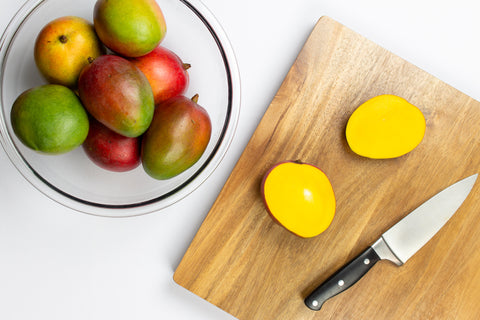
8. But Mexico is the leading exporter of mangoes around the world
Mexico grows a lot of mangos. According to mexicanmangoes.com, “Mexico is the global leader in exporting mangoes to the world. Mexican exports in 2017 reached a record level of 422,000 tons, demonstrating a rising trend with annual growth of 11.25% over the last five years. The bulk of the export goes to the US and most of the rest goes to Canada.
“At present, Mexico exports around 21% of its total production of mangoes, meaning that its installed capacity can be further leveraged to reach consumers from all around the world.”
The second largest mango exporting country is a little less intuitive. In fact, you probably would never guess that the second largest exporter of mangos worldwide is... the Netherlands. If you’re scratching your head and thinking, aren’t mangos a tropical fruit?, you’re not alone, I thought the same thing. The truth is, the Netherlands exports 80% of what it imports. It’s the mango capital of the EU, serving as a hub for mangos (and other fruits and vegetables) headed to other European nations.
9. The United States imports more mangoes than any other country in the world
In 2017, the United States imported $656.4M worth of mango, including fresh, dried, frozen, juiced and preserved mango, making up over 23% of global mango imports.
According to Manuel Michel of the National Mango Board, "US mango per capita consumption has increased steadily since 2005 from 1.88 pounds/person, to 3.42 pounds/person in 2017, and represents a growth of 82 percent. Going back twelve to fifteen years, there are three fundamental developments from the supply side that are driving this growth: more availability, better quality, and more value-added options for consumers."

Mexico is the main supplier of mango (particularly fresh mango) to the United States, but dried mango is also imported from Thailand and the Philippines, and frozen mango from Peru.
Why not Indian mangoes, you ask? Mangoes from India must pass stringent tests and go through quarantine when arriving into the United States due to fruit fly and pesticide concerns. In fact, the United States banned Indian mango imports in the 1980s. President Bush lifted the ban in 2007, and in exchange, the Indian government agreed to lift the ban against importing Harley Davidson motorcycles. Politics is so weird. The EU lifted a similar ban on Indian mangoes only last year.
According to the USDA, “As a condition of entry, the mangoes must undergo irradiation treatment and be accompanied by a phytosanitary certificate with additional declarations providing specific information regarding the treatment and inspection of the mangoes and the orchards in which they were grown. In addition, the mangoes will be subject to inspection at the port of first arrival. This action allows for the importation of mangoes from India into the continental United States while continuing to provide protection against the introduction of quarantine pests.”
10. You can peel a mango with a pint glass
I saved the best for last. When I first discovered mango, it was in the pre-peeled-and-sliced form, boxed neatly in plastic at the grocery store. I continued buying packaged mango (when I could afford it, which wasn't often) because my first experience with peeling a mango myself was ridiculously messy and I wasted half the mango because I didn’t know how to peel and slice it properly. I was more than happy to pay the grocery store to do this terrible work for me. But NOT anymore!
Lo and behold, I came across the pint glass method for peeling mango. And let me tell you, it changed my life.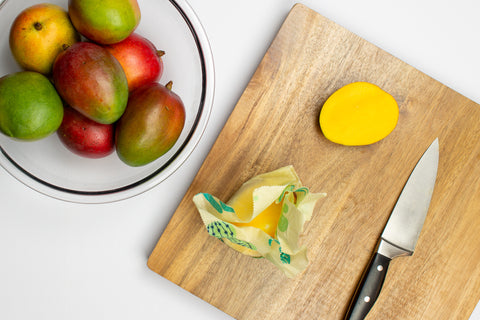
While still a little messy, the pint glass method is the easiest way to peel a mango. Rather than trying to explain it to you, check out this short video from Melissa Bailey. And if you're using half at a time, Ideal Wrap is the perfect way to save the other half for later!
She also demonstrates how to cube a mango, which is great when adding mango to recipes, like this grilled mango and shrimp skewer recipe that I'm dying to try! Yum!
That's the list!
I hope you now feel like a mango expert! Are you ready to try out your new pint glass method and put some more mango in your life?
Do you cook with mango? Have a favorite mango smoothies recipe? What’s your favorite mango variety? Leave us a comment, we want to hear from you! But for now, I’m off to make a mango lassi!









Hi I’m chef ange from ange vibes kitchen on YouTube..I just made a jerk mango sauce for a jerk tofu, I just did..and I make salads..juice and mango bbq sauce..the list is endless..i live in Jamaica and it’s mango season now so I use them up